Writing box index

History
of writing boxes
Request
current list of available writing boxes.
Online
History of boxes
| |
Antique Writing slope in rosewood with brass inlay circa
1820
Please click on images to enlarge | slide show | thumbnail
index |
Reference: WB463
Description:
WB463: Writing slope in rosewood with brass inlay circa 1820.
This slope is an excellent example of the Regency. It is veneered in saw cut rosewood on mahogany and it is inlaid in brass. This form of inlay was inspired by French Boulle work, but was evolved into a more robust genre by English cabinet makers such as George Bullock, who was one of the Prince Regent’s/George IV favourites. The design of the inlay is symmetrical and follows neoclassical tradition, the flora being stylised and incorporating such motifs as the palmette, the acanthus and a central urn. A hint of naturalism creeps in with the flowers and the wavy movement, suggesting the next period of more life-like development. The colour and lustre of the brass contrasts nicely with the colour of the rosewood. Thomas Hope, the distinguished designer, (1807 ‘Household Furniture and Interior Decoration executed from Designs by Thomas Hope’) advocated metal inlay on dark wood ‘….that distinctness and contrast of outline, that opposition of plain and enriched parts…..’
Inside the box has lidded compartments for pens, wax etc and two screw top distinctive inkwells.
The writing surface is framed by a crosbanding in tulip wood the figure slanting symmetrically around the gold embossed leather surface. The leather is a replacement.
Working lock and key.
Origin: UK
Circa: 1820
|
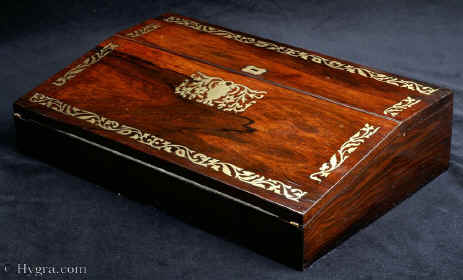
See Figure 492, 66, 67, and 68. Antique
Boxes, Tea Caddies, and Society, 1700--1880
Antigone Clarke & Joseph O'Kelly, ISBN: 0764316885
Size: 40.5 cm by 25.5 cm by 95 (65) cm high when
closed: 15.9 inches by 10 inches by 3.7 (2.5)
inches high when closed.
|
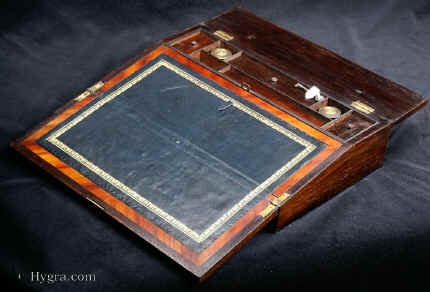
|
Inside the box has lidded compartments for pens, wax etc and two screw top distinctive inkwells.
The writing surface is framed by a crosbanding in tulip wood the figure slanting symmetrically around the gold embossed leather surface. The leather is a replacement.
|
Please click on images to enlarge | slide show | thumbnail
index |
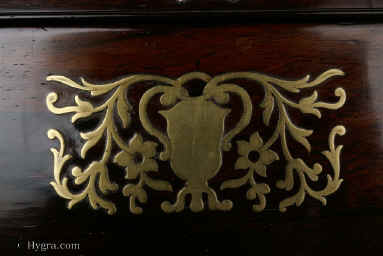
|
The design of the inlay is symmetrical and follows neoclassical tradition, the flora being stylised and incorporating such motifs as the palmette, the acanthus and a central urn. A hint of naturalism creeps in with the flowers and the wavy movement, suggesting the next period of more life-like development. The colour and lustre of the brass contrasts nicely with the colour of the rosewood.
|
Inside the box has lidded compartments for pens, wax etc and two screw top distinctive inkwells.
The writing surface is framed by a crosbanding in tulip wood the figure slanting symmetrically around the gold embossed leather surface. The leather is a replacement.
|
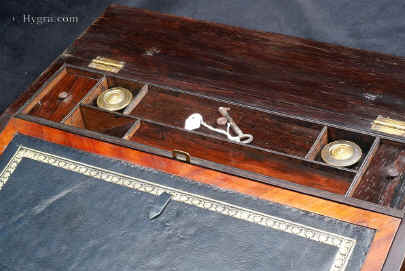
|
Please click on images to enlarge| slide show | thumbnail
index |
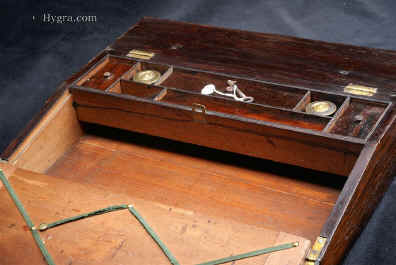
|
Under the writing surface there is a space for keeping
papers. |
Please click on images to enlarge
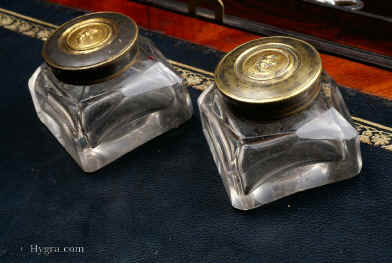
|
Two screw top distinctive inkwells.
The glass would have been blown in a mold and then the facets would have
been cut.
|
Inside the box has lidded compartments for pens, wax etc and two screw top distinctive inkwells.
|
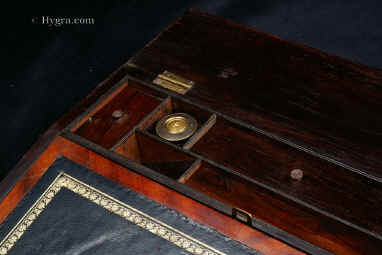
|
Please click on images to enlarge| slide show
| thumbnail
index |
This form of inlay was inspired by French Boulle work, but was evolved into a more robust genre by English cabinet makers such as George Bullock, who was one of the Prince Regent’s/George IV favourites. The design of the inlay is symmetrical and follows neoclassical tradition, the flora being stylised and incorporating such motifs as the palmette, the acanthus and a central urn. A hint of naturalism creeps in with the flowers and the wavy movement, suggesting the next period of more life-like development. The colour and lustre of the brass contrasts nicely with the colour of the rosewood. Thomas Hope, the distinguished designer, (1807 ‘Household Furniture and Interior Decoration executed from Designs by Thomas Hope’) advocated metal inlay on dark wood ‘….that distinctness and contrast of outline, that opposition of plain and enriched parts…..’
|
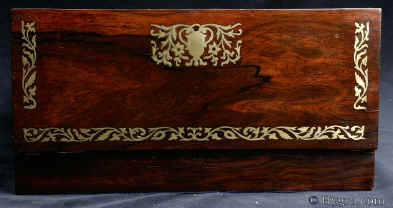
|
Please click on images to enlarge| slide show | thumbnail
index |
Please click on images to enlarge| slide show | thumbnail
index |
Please click on images to enlarge| slide show
| thumbnail
index |

|
The underside is covered in
felt.
|
Please click on images to enlarge
Request
current list of available writing boxes.
News
| Buying
| email | Online
History of boxes | The
Schiffer Book |
All text and images and linked images are ©
1999-2009 Antigone Clarke and Joseph O'Kelly. If you require any further
information on permitted use, or a licence to republish any material, email us
at copyright@hygra.com
|
